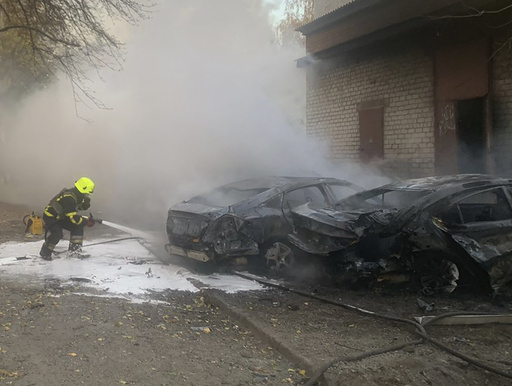KYIV, Ukraine — The United States has decided to permit Ukraine to utilize American-provided long-range weaponry for strikes within Russian territory, fulfilling a long-standing request from Kyiv.
It remains uncertain whether there will be restrictions on Ukraine’s use of the Army Tactical Missile System, or ATACMS, as has been the case with other U.S. missile systems. Initially, these weapons might only be employed in the Kursk region of Russia, where Ukrainian forces previously gained ground this year.
Since the onset of the conflict, Ukrainian officials have actively sought support from Western allies to utilize advanced weapon systems for targeted strikes deep within Russia. They believe this strategy could diminish Moscow’s military capabilities before their troops advance to the eastern front, while also complicating Russian operations in Ukrainian territory. Furthermore, it could serve as a strategic deterrent during any potential cease-fire discussions.
Historically, the U.S. has been reluctant to endorse such actions, with President Joe Biden focused on avoiding any escalation that might lead to direct confrontation with nuclear-capable Russia. In response to this latest decision, the Kremlin has cautioned that such measures could exacerbate the ongoing conflict.
This announcement comes during the closing days of Biden’s presidency, just before President-elect Donald Trump takes office. Trump has openly expressed intentions to rapidly resolve the war, raising concerns that it might lead to significant concessions from Kyiv.
The ATACMS, developed by Lockheed Martin, is capable of striking targets nearly double the distance—up to 300 kilometers (approximately 190 miles)—compared to most existing weaponry in Ukraine’s arsenal. These missiles allow for precise attacks on vital military installations, including airfields and supply depots.
Last year, the U.S. supplied Ukraine with ATACMS, which have already been deployed against military targets in Russian-occupied Ukrainian areas, but not directly on Russian soil.
As per U.S. officials and others knowledgeable about the situation, Biden has authorized Ukraine to utilize the ATACMS to reach further into Russian territory. Such deployments are likely a response to North Korea’s decision to send troops in support of Russian forces, particularly aimed at countering Ukrainian maneuvers in the Kursk region, where they initiated a incursion earlier this year.
Notably, this marks the second occasion on which Washington has allowed Ukraine to engage with its weapon systems within Russian borders. Earlier, in May, Biden authorized the use of HIMARS systems—which have a shorter range of 80 kilometers (50 miles)—to counteract a Russian advance threatening Ukrainian defensive capabilities in the Kharkiv region. This earlier measure aided Ukrainian troops in stabilizing the situation by compelling Russian forces to withdraw some of their military assets.
Ukraine’s persistent requests for longer-range weapons stem from a desire to alter the current balance of power, as Russia maintains a more abundant arsenal. Kyiv aims to strike critical facilities such as air bases and supply lines situated hundreds of kilometers beyond the border, thereby undermining Russia’s air dominance and logistics which support ongoing military operations against Ukraine.
Employing these weapons in the Kursk region would likely necessitate that Russian forces reposition their resources to mitigate counterattacks, thus complicating their operational strategies. In the absence of foreign military assistance, Ukraine has conducted strikes into Russia using domestically produced systems capable of reaching up to 1,000 kilometers (620 miles); however, these have not proven sufficient for substantial long-term impact.
The impact of this tactical shift in weapon deployment largely hinges on the specific guidelines set forth for their usage. Should Ukraine be allowed to strike throughout all of Russia, it could significantly disrupt Moscow’s strategic military responses. Conversely, if strikes are confined to the Kursk region, Russian forces would likely relocate critical command centers and air units to adjacent areas, potentially diminishing the overall effectiveness of Ukrainians’ targeting goals.
Ukrainian officials are adopting a cautious approach to this announcement. President Volodymyr Zelenskyy remarked that while there may be media speculation about the ramifications of this decision, actual military actions will speak volumes without excessive fanfare.
According to Pentagon spokesman Lt. Col. Charlie Dietz, the ATACMS may not address the main threat posed by Russian glide bombs, which can be fired from more than 300 kilometers (180 miles) away, well beyond the range of the ATACMS. Furthermore, there is concern that Russian forces have had adequate time to reposition their assets, diminishing any immediate impact of the new authorization.
Analysts suggest that earlier approval for such military capabilities might have disrupted Russian counteroffensive strategies in the Kursk area. Additionally, U.S. officials have voiced reservations about the current supply of ATACMS, questioning whether enough could be provided to Ukraine for a meaningful impact. Nonetheless, some advocates believe that even a few strikes further into Russia could force changes in military deployment and resource allocation.
This decision may also act as a catalyst for other nations, such as Britain and France, to permit Ukraine to utilize missiles like Storm Shadow, which possess a range of 250 kilometers (155 miles).
Home World Live International Crisis Implications of Biden’s Approval for Ukraine to Utilize Advanced US Long-Range Weapons
